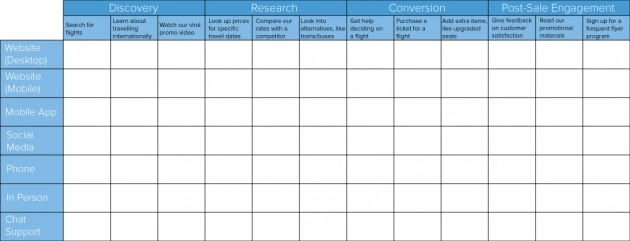
What is customer journey mapping?

Customer journey mapping serves as a critical exercise for teams dedicated to improving how customers discover, interact with, and grow loyal to their products, services, and brand. This article sets out to demystify the concept of journey mapping by providing a detailed exploration of its process, significance, and impact. Through journey mapping, businesses can identify and dismantle the barriers hindering customer engagement and satisfaction, thereby enhancing their path to conversion and loyalty.
In this article, we'll delve into the specifics of what makes an effective customer journey map, the stages involved in creating one, and how it can serve as a cornerstone for decision-making aimed at fostering a customer-centric culture. By the end of this piece, readers will gain a comprehensive understanding of customer journey mapping as not just a tool for visualization, but as a strategic asset for aligning business operations with the needs and expectations of their customers.
What is a customer journey map?
A customer journey map is a visual representation that illustrates the steps your customers go through in engaging with your company, whether it be a product, an online experience, retail experience, or a service, or any combination. It’s a holistic view that captures every experience and emotion your customers encounter, highlighting both the high points and the pain points of their journey. By plotting out these interactions step by step, from initial discovery through various stages of engagement to long-term loyalty, organizations gain invaluable insights into where they excel and where obstacles exist that may deter customers.
GUIDE
Enhance brand reputation for long-term success
This guide provides a proven playbook for strengthening your brand’s reputation.
Because there’s a gray area in the differences between a “customer” and a “user,” product designers and marketers tend to use the terms “customer journey map,” “user journey map,” “buyer journey map,” and sometimes “empathy map” interchangeably.
Lots of teams map the customer journey to develop empathy for the customer. It helps them keep the customer’s needs and intentions at the center of their decisions. This is a must for companies that want to be customer-centric.
The important thing to understand is that these labels refer to the same exercise of visualizing a person’s journey of interactions with a product or experience. It’s an extremely valuable exercise that'll give you a clear picture of the interactions customers have with your brand—both positive and negative. And it’ll help you discover opportunities to increase conversions and provide a better customer experience. Ultimately, organizations create customer journey maps to have a single source of truth for understanding their customers and their experience.
Today, organizations must do all they can to capture the attention and delight of customers. That’s why customer journey mapping is an essential framework organizations use to get a bird’s eye view of the entire customer experience to optimize customer interactions before, during, and after the buying process.
Related reading: What’s the difference between CX and UX?
Using touchpoints in your customer journey map
A good customer journey map thoroughly explores each customer interaction with the brand. These interactions between customer and brand are called “touchpoints.” They come in both physical and digital forms. Examples of physical touchpoints include billboards, mail, in-store experiences, and interactions with salespeople.
Digital touchpoints can happen via social media, email, search engines, film, video, podcasts, in-app experiences, and more. As technology becomes more integrated with the physical world, the lines between physical and digital touchpoints will continue to blur. Already, brands are using omnichannel testing to ensure a consistent experience that can start on one piece of tech and end on another.
Related reading: What’s the difference between multichannel and omnichannel?
The size and scope of customer journey mapping
Customer journey maps vary widely. For some organizations, their business revolves around one customer journey map. Larger organizations could have dozens of products with multiple maps associated with each.
Generally speaking, marketing and sales teams create customer journeys focused on problem recognition, information search, solution comparison, and purchase evaluation. Product design and UX teams create customer journey maps for different product “flows” or key moments that occur while customers use the product. Of course, these two realms frequently overlap. The best organizations have thorough multichannel testing procedures to ensure the brand experience is consistent across devices and experiences.
How customer journey maps improve customer experiences
With technological advances, organizations have more potential touchpoints than ever. At the same time, customers’ attention spans and tolerance for subpar experiences are shrinking.
Customer journey maps are like a map of the battlefield for organizations. They’re vital. Without a single source of truth to rally around, internal conversations tend to go nowhere. Stakeholder disagreements abound, and wheels spin as teams toss ideas around with little rationale to back them up. Real human needs tend to fall by the wayside as speculation and guesswork drive decision-making.
Organizations today must ensure that a person’s journey from customer to lifetime advocate is seamless. To retain customers, customers’ experience of the product must be delightful and consistent with the journey that first drew them in. Journey maps are useful tools that provide clarity and allow organizations to be more strategic as they refine their offerings.
Understanding the customer and their challenge
Teams create a customer persona to fully understand the human experience behind the problem they’re trying to solve. Teams need to know details like age, role, preferences, feelings, and more before they think about brainstorming solutions. To fully understand the problem customers need to be solved, look at any methods customers currently employ to reach their goals. Create competitor audits and conduct qualitative or qualitative research to identify pain points and customer behavior. Note any moments of friction or opportunities for innovation in your findings.
4 stages of a customer journey map
The customer lifecycle has four general stages:
Awareness
At this initial stage, prospects become aware of a potential product or service as a solution to their problem. This awareness can stem from various sources: social media content, word-of-mouth recommendations, advertising, or even a search engine result. It's crucial for brands to identify the most effective channels for reaching their target audience during this phase. The goal is to make a strong first impression that not only informs the prospect about the product but also engages them on an emotional level, prompting them to learn more.
Consideration
Once prospects are aware of their options, they move into the consideration stage, where they gather more information and evaluate the different solutions available. This is where detailed product information, user reviews, and comparison content play a significant role. Brands should focus on providing comprehensive resources that help prospects understand how their offering solves the problem more effectively than competitors. Content formats such as webinars, case studies, and detailed guides are particularly effective in engaging customers at this stage.
Decision
The decision stage is a critical juncture where a prospect chooses whether or not to purchase a product or service. At this point, factors like price, customer service, warranty, and return policies can significantly influence the final decision. Brands need to ensure that all questions or concerns are addressed promptly, offering personalized communication through channels like live chat or direct emails. Demonstrating value through free trials or demonstrations can also tip the balance in favor of a brand.
Retention
After the purchase, the focus shifts to retaining the customer and nurturing their loyalty. This phase is about ensuring the product or service lives up to the promises made during earlier stages. Follow-up emails, customer support, loyalty programs, and requests for feedback are all part of maintaining a positive relationship with the customer. Additionally, providing ongoing value through educational content, updates, and exclusive offers can encourage repeat business and referrals.
Product teams track behavior across every phase of the customer lifecycle. Creating detailed customer journey maps for each phase allows teams to identify and optimize every touchpoint in the customer's interaction with the brand. Depending on the complexity of their offerings and the diversity of their customer base, organizations may develop a single comprehensive journey map or multiple maps focusing on different aspects of the customer experience. This flexibility makes journey mapping a valuable tool for understanding and enhancing the customer's path, whether viewed from a broad perspective or in specific, targeted scenarios.
Things to remember about journey phases:
- Define the phases by the customer’s point-of-view, not your own. Making assumptions or guessing will not provide you with genuine, actionable insight.
- Remember to base each phase on actual observable customer behavior, not cold hard data.
- Create a model that can accommodate all scenarios.
- Provide clear definitions for each stage.
- Discuss it with others in the organization and get internal buy-in from executives.
Create a customer journey map template
With the customer persona and challenge documented, the team then establishes a primary goal that the customer or user will accomplish by the end of the journey map.
Creating a customer journey map template is a collaborative and strategic process that uncovers the path your customers take with your brand. This detailed mapping helps in visualizing the customer's experience from initial contact through various touchpoints and ultimately to long-term loyalty. Here’s how to approach it:
1. Define customer personas
Start by defining detailed customer personas. These personas represent your ideal customers based on market research and real data about your existing customers. Include demographics, behavior patterns, motivations, and goals. The more detailed you are, the better you can tailor the journey to fit their needs.
Here are a few questions to get you started on building your personas:
- How old is the customer?
- Where do they live?
- What's their gender?
- What industry do they work in?
- What's their highest level of education?
- What's their profession?
2. Identify goals and challenges
Understand the primary goal of your customer journey map. Are you focusing on a specific part of the journey or looking at the entire lifecycle? Identify the main challenges your customers face at each stage of their journey. This understanding will guide the creation of your map.
3. List customer touchpoints
Identify all possible customer touchpoints. These are all the places where customers come into contact with your brand, both online and offline. Don’t overlook indirect touchpoints like reviews and social media mentions. Mapping out these touchpoints will help you see the journey from the customer's perspective.
4. Document the stages of the journey
Break down the customer journey into detailed stages—Awareness, Consideration, Decision, and Retention. For each stage, list out what the customer is doing, thinking, and feeling. This step will require gathering data from various sources, including sales data, customer feedback, and web analytics.
A simple way to list each stage is by creating a table that demonstrates the action the customer performs, what emotions and thoughts they might be having during that action, and how to track or measure it. An example breakdown could be:
Consideration stage
- Action: The customer is comparing products.
- Thoughts and emotions: The customer is feeling uncertain and questioning, “Which product is the best fit for me?”
- How to track: Gather customer feedback through surveys or reviews, analyze engagement rates on content related to product comparison, or use heatmaps to track user behavior.
5. Identify customer needs and company inputs
Determine what information the customer needs to move to the next stage in their journey and what actions you want them to take. Also, consider what information your company needs to gather from customers to better serve them at each touchpoint.
6. Highlight choices and feedback opportunities
Outline what options customers have at each stage of the journey and how they can provide feedback. This might include product choices, service levels, or channels for communication. Make sure there are mechanisms in place for capturing this feedback.
7. Note critical moments and touchpoints
Identify critical moments in the journey that are make-or-break points for customer satisfaction and conversion. Pay extra attention to these moments to ensure they are as positive and seamless as possible.
8. Estimate the journey duration
Provide an estimate of how long the entire journey will take from the customer's perspective. This helps in setting realistic expectations and identifying any stages that may take longer than they should.
9. Address internal bottlenecks
Identify any internal processes or policies that could be creating bottlenecks or roadblocks in the customer journey. These are areas where internal changes could significantly improve the customer experience.
10. Map out each step sequentially
With all the above information at hand, start laying out the journey map. Use a format that allows you to visually represent each stage, touchpoint, customer action, thought, and emotion, and align your internal actions accordingly.
11. Collaborate and refine
Creating a customer journey map is not a one-time task but a continuous process of refinement. Share the map with different teams within your organization to get their insights and make necessary adjustments. The goal is to create a map that is as accurate and actionable as possible.
Finalizing your customer journey map template
Once your journey map is laid out, use it to identify areas for improvement, innovate on customer touchpoints, and ultimately enhance the overall customer experience. Remember, the map should evolve as your customers and your business do, making regular updates and reviews a key part of your strategy.
Now that the data has been gathered, the team collaborates to map out every step of the customer journey. Stages of the customer journey map are laid out sequentially, and important data from the above list (touchpoints, customer feelings, needs, choices, etc.) are organized underneath each stage.
Take a look at these 4 steps for building the customer journey map:
To draw out your map, you can use a whiteboard, paper and sticky notes, or a spreadsheet. There are also several online tools that you can use to build your map, like UXPressia and Canvanizer.
1. Identify the stages of a customer's interaction with your brand
Whatever medium you choose, the first step is to identify the stages of a customer’s interaction with your brand, from when they first hear about your company through the point when they become a brand advocate and customer for life. It will probably be something like this: discovery, research, conversion, and post-sale engagement.
2. Break down stages into activities
Next, break those stages into common activities that customers will complete at that part of their journey. For example, the Discovery phase for an airline company might have activities like “Search for a flight for an upcoming trip” or “Learn about traveling internationally.” Plot the stages and their activities across the top of your map:
3. Fill out the different channels
Now we’re going to fill out the different channels. Think of the ways your customers interact with your brand. You’ll probably want to include channels like Website (Desktop), Website (Mobile), Mobile App, Social Media, Phone, In-Person, and Chat Support. Plot these out on the left side of your map, from top to bottom.

4. Fill out the customer journey map
For this step, you’ll need to think about your personas. Which activities do they complete along their customer journey? Which channels do they use for each activity?
Remember, the exact journey isn't the same for each customer. Some customers will make a quick decision and move from discovery to purchase right away on a single channel. Others will take more time to research, compare, and ask questions across several channels.
For each persona, plot a point for each activity on the map and then connect the dots.

How to improve your customer journey maps
Creating a customer journey map is a critical step in understanding and enhancing the customer experience. However, the work doesn't stop once the map is created. Continuous improvement is key. Here are steps to refine and enhance your customer journey maps:
1. Gather comprehensive data
Start with a broad collection of data from various sources to ensure a complete understanding of the customer experience. Utilize analytics tools to gather quantitative data about how customers interact with your website, social media channels, and other digital platforms. Combine this with qualitative feedback from customer interviews, surveys, and feedback forms to understand the why behind their actions.
2. Implement A/B testing
Use A/B testing to experiment with changes in the customer journey and directly measure their impact on customer behavior and satisfaction. Test different aspects of your website, email campaigns, and other touchpoints to see what resonates best with your audience. This approach allows for data-driven decisions that can lead to more effective customer interactions.
3. Engage with customer feedback
Actively seek out and listen to customer feedback at all stages of the journey. This can include direct feedback from surveys and social media, as well as indirect feedback through behavior analysis and customer support interactions. Understanding customer feelings and experiences is crucial for identifying areas for improvement.
4. Map emotional journeys
Beyond the physical touchpoints and actions, map out the emotional journey of your customers. Identify the highs and lows in their experience and consider how you can enhance the positive emotions while addressing and mitigating the negative ones. Emotional mapping can reveal insights into customer loyalty and satisfaction that traditional touchpoint analysis might miss.
5. Utilize cross-functional teams
Involve teams from across your organization in the journey mapping process. Sales, customer service, marketing, and product development teams can all provide unique insights into the customer experience. Collaboration ensures a more comprehensive understanding and identification of opportunities for improvement.
6. Regularly update your maps
Customer behaviors and expectations evolve, and so should your customer journey maps. Make it a regular practice to review and update your maps based on the latest data and feedback. This ensures your strategies remain relevant and effective in meeting customer needs.
7. Prioritize actionable insights
As you identify areas for improvement, focus on actionable insights that can have a tangible impact on the customer experience. Prioritize changes that offer the most significant benefit to your customers and your business, and plan for implementation in stages if necessary.
8. Measure and iterate
After implementing changes, closely monitor their impact. Use key performance indicators (KPIs) relevant to each stage of the customer journey to measure success. This could include conversion rates, customer satisfaction scores, or net promoter scores (NPS). Use these metrics to iterate and further refine your customer journey maps over time.
Leveraging your Improved customer journey maps
By following these steps, marketing and design teams can not only improve their customer journey maps but also ensure they are continually evolving to meet customer needs. Improved journey maps can lead to enhanced customer experiences, increased loyalty, and ultimately, greater business success.
How to use a customer journey map
Here’s where things get fun (and actionable)! You’ll use the map to find opportunities to increase conversions and improve the customer experience.
Plotting your known high points and low points
First, mark your known pain points on the customer journey map.
A great starting place is to check in with your support team and find out what problems they address daily. For example, they might tell you that site visitors often chat because they’re confused about the pricing on your website.
You can also use any survey results you already have to find any problem areas. You might have a customer satisfaction survey that shows that your customers think it takes too long to get through to anyone on the phone when they need help.
Now, you’ve already identified a couple of optimization opportunities! Go ahead and mark them on the map.
You can do the same thing for places where you’re currently doing great. Do you often hear positive feedback from customers about how smooth your signup process is or how helpful your content marketing is? Add that to the map!

Discovering new opportunities
What about the interactions that aren’t positive or negative? At this point, you’ll use your analytics data and qualitative feedback to fill in the gaps in your customer journey map.
Maybe there are places where you might suspect there’s room for improvement, but you’re not sure what’s going wrong or what needs to be fixed. For example, when you look at your analytics, where are visitors bouncing from your site, abandoning their orders, or unsubscribing from your emails? When do they stop replying to your sales team’s outreach efforts? These actions tell you that there’s room for improvement and optimization.
So how do you determine what’s going wrong at these points? The best bet is to ask your customers directly. Ask questions like:
On a scale of 1 (very unlikely) to 10 (very likely), how likely would you be to recommend our company to a friend, and why?
What would you change about this product if you had a magic wand?
How did your experience today compare to your expectations? Why?
You can ask these questions via a survey, a user test, or even over the phone, depending on what stage you’re investigating.
By now, your map should be getting pretty full. Give yourself bonus points if you can add a few words describing the customer's mindset at each interaction.
Testing a customer journey map
To test a customer journey map, teams need a strong balance of qualitative and quantitative data to understand what it’s like to be their customer.
Quantitative data for customer journey maps
Quantitative research gives teams a high-level view of customer behavior at each stage of the journey map. The data is focused on understanding behavior in numbers. The more customers who go through the journey map, the better teams will be able to identify trends.
Suppose a team is gathering quantitative data on a journey map for their website, for instance. In that case, they’ll look at factors like traffic sources, conversion rates, drop-offs, heatmaps, treemaps, and more to understand the moves customers make at each touchpoint. Quantitative data can also include survey responses, ratings, A/B tests, or web analytics that might help the team benchmark performance.
Qualitative data for customer journey maps
Often, quantitative data will illuminate problems that only qualitative data can solve. It’s valuable to know that customers are dropping off at a specific touchpoint, but understanding why they’re dropping off is the key to innovation.
Qualitative testing allows teams to drill deeper into human behavior's reasons. This type of research is focused on subjective emotional components and non-numerical data. Teams seek to understand customers’ values, opinions, and choices based on observation and user interviews.

Mitigating risk resources
Bring customer perspectives into more decisions across teams and experiences to design, develop, and deliver products with more confidence and less risk.





